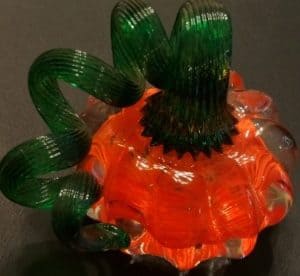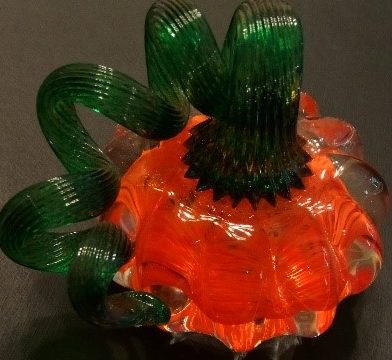 After a recent jaunt to Sandwich, I reflected back on my first trip to “Cape Cod’s Oldest Town” where I visited the famous Glass Museum. There is a large collection of both blown and pressed glass pieces, as well as many artifacts found in the grounds long after the factory was closed. The Museum makes for an interesting few hours, especially if you are a history buff, interested in Cape history, or blown glass – both the history of it and as an art form. The museum also puts on live glass blowing demonstrations, and these alone are well worth the trip. In fact, on Friday, July 19th, the Sandwich Glass Museum will be participating in the 2019 “Free Fun Fridays.” Admission is free for everyone! Check out their website at sandwichglassmuseum.org for more information.
After a recent jaunt to Sandwich, I reflected back on my first trip to “Cape Cod’s Oldest Town” where I visited the famous Glass Museum. There is a large collection of both blown and pressed glass pieces, as well as many artifacts found in the grounds long after the factory was closed. The Museum makes for an interesting few hours, especially if you are a history buff, interested in Cape history, or blown glass – both the history of it and as an art form. The museum also puts on live glass blowing demonstrations, and these alone are well worth the trip. In fact, on Friday, July 19th, the Sandwich Glass Museum will be participating in the 2019 “Free Fun Fridays.” Admission is free for everyone! Check out their website at sandwichglassmuseum.org for more information.
I had first seen glass blown at Greenfield Village at the Henry Ford Museum in Dearborn, Michigan, in the 1980’s. That was a wonderful first introduction to glass blowing. The artist first heated the glass up to a temperature of about 2000 degrees Fahrenheit, where it turned into molten (basically liquid) glass. To make the process even trickier, the glass blower had to work fairly quickly, as the glass needed to remain at a temperature of at least 1400 degrees Fahrenheit in order to remain pliable. I was soon lost in the swirl of glass colors, deft movements, and the excitement (Will he drop it? Will he burn himself?). I was truly fascinated by the entire experience. (See this glass blowing video.)
Knowing about my interest in glass blowing, my friend surprised me last October with a three hour glass blowing class at the Luke Adams Glass Blowing Studio right here in Norwood. We listened as the instructor explained all the tools and techniques, and showed us examples. We were able to jump in and design our own two items. I chose to make a glass and a pumpkin paperweight. I can tell you, the instructors make it look sooooo easy! The tools felt awkward and I was always aware of the heat. I didn’t give the glass quite enough air though, because it was squatter and much thicker than I intended. I had much better luck with the pumpkin, and that was done with a lot of support from the instructor, but it came out beautifully. The point is that I was able to experience glass blowing close up, to feel the tools in my hands and the heat on my face as I worked the glass. The three hours flew by! If I hadn’t already had an appreciation for this art form, I certainly did now.
Not long after I took this class, I was intrigued to see The Glass Blowers by one of my favorite authors, Dame Daphne Du Maurier. Like her more famous books such as Rebecca, Jamaica Inn, and her short story, The Birds, The Glass Blowers presents its own mixture of drama and tragedy as Du Maurier writes about glass blowing during the French Revolution. Even more intriguing, this is a semi-autobiographical historical fiction novel based on Du Maurier’s glass blowing predecessors of La Brulonnerie , Cherigny, La Pierre, and the Chesne-Bidault. Du Maurier uses the settings and characters of The Glass Blowers to tell the story of her own family, with all the accompanying unrest of the French Revolution and family pathos. This novel captures the spirit of glass blowing and shows the close community and family ties that grew in the midst of this specialized art form.
The story opens with Madame Sophie Duval, daughter of a glass blowing master and also the widow of one, meeting her nephew for the first time. Her brother, Robert Busson, had emigrated from France to England with his new wife, abandoning the glass house, his family, and his country due to poor financial decisions and threatened imprisonment. Robert eventually abandons England and his family and returns to his native France to die.
Robert’s son, Jacques, was brought up to believe that his French relatives were of the wealthy upper class, and that the family home was a beautiful chateau. Sophie quickly disabused him of these ideas, remarking that the family home was “no more than a farmhouse.” The rest of the novel portrays Sophie as she gives her long-lost nephew the true story of the Busson glass blowers. Sophie tells him, “A glass-blower, remember, breathes life into a vessel, giving it shape and form and sometimes beauty; but he can, with that same breath, shatter and destroy it.” Sophie unravels the story of her family from before the French Revolution to the five decades after it. Sophie’s quote exemplifies her brother Robert’s life, and the pain he caused his family with his unfortunate decisions.
I am a big fan of historical fiction as a genre, and can appreciate how Du Maurier takes it a step beyond by adding her personal touch. Du Maurier’s descriptions of the glass factory, her in-depth knowledge of the business of glass blowing and the personalities behind them make for a very satisfying and informative read.
Carla Howard is Senior Circulation and Media & Marketing Assistant at the Morrill Memorial Library in Norwood, MA. Look for her article in the June 6, 2019 issue of the Transcript & Bulletin.



